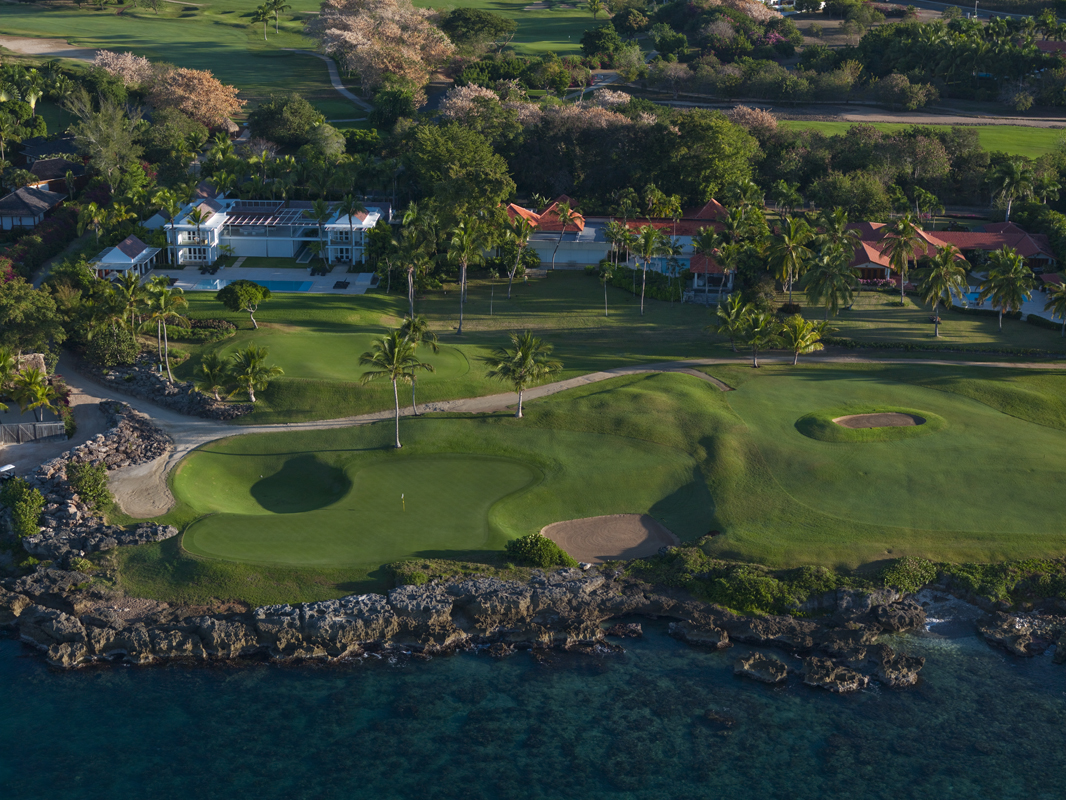
Casa de Campo Resort here in the Dominican Republic made its mark because the first of its four separate courses, Teeth of the Dog, was designed by the inimitable Pete Dye. Of course, Dye designed all 63 holes here, but it was the Teeth of the Dog layout, opened in 1971, that got the place noticed and today enjoys a place on most everyone’s world top 100 list.
However, while Dye made his own mark with some of golf’s most striking, flamboyant feature work — the volcano green complexes, the hard-edged fairways that fall off steeply 10-15-20 feet into strip bunkers (PGA West), the ubiquitous railroad ties, the island-greens (typified by the 17th at TPC Sawgrass) — Teeth of the Dog features almost none of these things.
One of the most striking things about my round here this morning was this: the features at Teeth of the Dog were surprisingly graceful, almost sedate. There are a few plateau greens that fall of steeply on every side (the par-3 13th, for example), but the mounding, green edges and fairway edges here are largely quite tame. Most of the fairway bunkering is fairly shallow.
Here’s why: Dye’s designs are all about angles, and there are enough here — in tandem with ocean-derived wow factors — to moot the need for flamboyant design features.
Ordinary designers deploy putting surfaces as a sort of period at the end of a fairway; they are almost continuations of the fairway footprint. Dye doesn’t do that. The front of his greens may well connect to fairways, but the green remainders angle away from the player — meaning approaches inevitably require shots over a bunker or deep swale or water in order to find said greens. If the drive is exactly perfect, Dye rewards you with a royal road into his putting surfaces. For all the wayward among us, any deviation from the perfect line means your approach is that much tougher.
The angles Dye created at Teeth of the Dog meet his high standards, and it’s not just the green angles. Every tee box presents the player with a fairway that angles away left or right — attack that angle well (often over a hazard of some kind) and you shorten the hole; fail to do so and the holes is lengthened.
What makes Teeth of the Dog “world-class” is that Dye takes these angles down to the sea, where seven of the 18 holes use the Caribbean to complement his angles, thereby ratcheting up the risk-reward dynamic. The par-4 16th is a lovely example. It plays just 334 yards from the blue tees, but it hugs a cliff top where the ocean borders the entire right side. Dye’s fairway swings inland, away from the water, before tacking back to a green that sits right at the cliff edge. The closer you hug the coastline, the easier your approach — the Caribbean is still your right, but you can always bail out left. Should you bail out left off the tee, however, your approach plays almost directly at the ocean — the slightest push and the waves eat your ball.
Still, there are plenty of fun features at Teeth of the Dog, and it’s the hard edge that makes Dye’s features so striking. His putting surfaces don’t slope off gradually into greenside bunkers — they fall off steeply. It’s all or nothing. You’re either on that green or in the bunker, or in a swale. It’s sort of like a water hazard: There is no in-between — you’re either in it or not.
Teeth of the Dog features relatively little of these hard edges, to accompany the masterful angle work, perhaps because on 7 holes, Dye had the menacing Caribbean with which to work (made all the more knee-knocking by surf crashing over huge, gnarly, volcanic boulders). I suppose you don’t need hard edges all over the course with the ocean so close. It forms the ultimate hard edge.

The 15th green at Teeth of the Dog. This is the approach angle if you bail out away from the water. Note the hard edge at right — you’re either on the green, or in the Caribbean,
